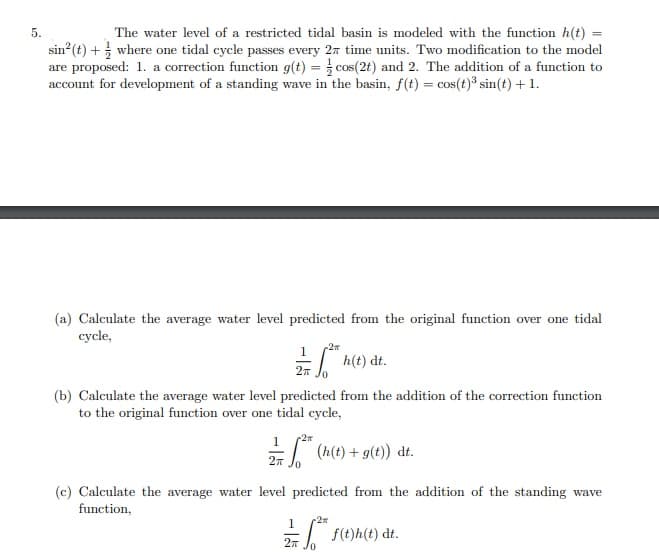5. The water level of a restricted tidal basin is modeled with the function h(t) = sin (t) + where one tidal cycle passes every 27 time units. Two modification to the model are proposed: 1. a correction function g(t) = cos(2t) and 2. The addition of a function to account for development of a standing wave in the basin, f(t) = cos(t)³ sin(t) +1. (a) Calculate the average water level predicted from the original function over one tidal cycle, - h(t) dt. 27 (b) Calculate the average water level predicted from the addition of the correction function to the original function over one tidal cycle, r2x (h(t) + g(t) dt. (c) Calculate the average water level predicted from the addition of the standing wave function, E f(t)h(t) dt.
5. The water level of a restricted tidal basin is modeled with the function h(t) = sin (t) + where one tidal cycle passes every 27 time units. Two modification to the model are proposed: 1. a correction function g(t) = cos(2t) and 2. The addition of a function to account for development of a standing wave in the basin, f(t) = cos(t)³ sin(t) +1. (a) Calculate the average water level predicted from the original function over one tidal cycle, - h(t) dt. 27 (b) Calculate the average water level predicted from the addition of the correction function to the original function over one tidal cycle, r2x (h(t) + g(t) dt. (c) Calculate the average water level predicted from the addition of the standing wave function, E f(t)h(t) dt.
Linear Algebra: A Modern Introduction
4th Edition
ISBN:9781285463247
Author:David Poole
Publisher:David Poole
Chapter6: Vector Spaces
Section6.7: Applications
Problem 18EQ
Related questions
Question

Transcribed Image Text:The water level of a restricted tidal basin is modeled with the function h(t)
sin (t) + where one tidal cycle passes every 27 time units. Two modification to the model
are proposed: 1. a correction function g(t) = cos(2t) and 2. The addition of a function to
account for development of a standing wave in the basin, f(t) = cos(t)³ sin(t) + 1.
5.
(a) Calculate the average water level predicted from the original function over one tidal
cycle,
1
-2x
h(t) dt.
(b) Calculate the average water level predicted from the addition of the correction function
to the original function over one tidal cycle,
-27
1
E (h(t) + g(t)) dt.
(c) Calculate the average water level predicted from the addition of the standing wave
function,
-2x
1
: f(t)h(t) dt.
Expert Solution
This question has been solved!
Explore an expertly crafted, step-by-step solution for a thorough understanding of key concepts.
Step by step
Solved in 2 steps with 2 images

Recommended textbooks for you

Linear Algebra: A Modern Introduction
Algebra
ISBN:
9781285463247
Author:
David Poole
Publisher:
Cengage Learning

Linear Algebra: A Modern Introduction
Algebra
ISBN:
9781285463247
Author:
David Poole
Publisher:
Cengage Learning